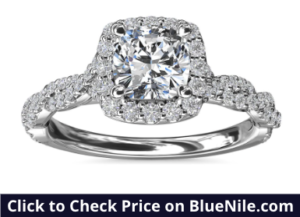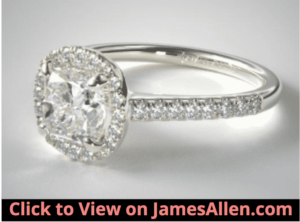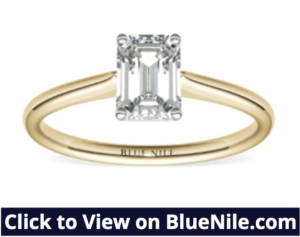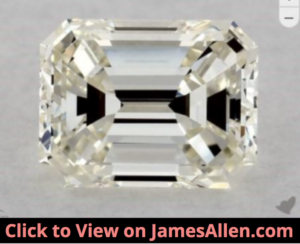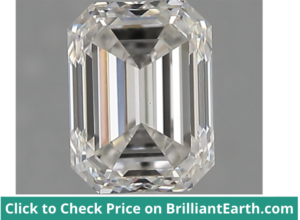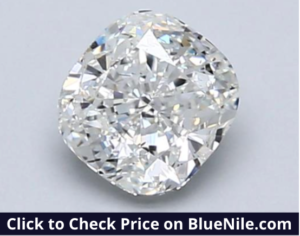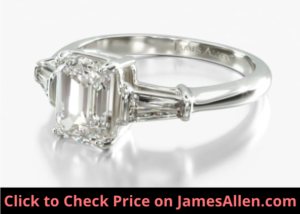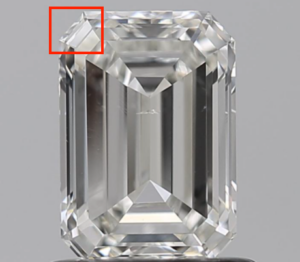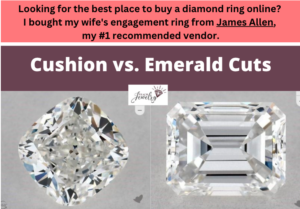
There are a variety of diamond cuts that all have unique shapes and features. Two choices are cushion and emerald cuts.
The main difference between cushion and emerald cut diamonds is cushion cuts have brilliant cut facets and a squarish shape. Emerald cuts are step-cut diamonds with four sides and cropped corners. They exhibit a warmer glow than cushion cuts because of their elongated facets.
Let’s compare cushion versus emerald cut diamonds across their nine differences, such as shape, brilliance, clarity, and more.
What are Cushion Cut Diamonds?
Cushion cut diamonds combine rounded corners with a square cut.
It’s a pillow-like shape that is sometimes slightly rectangular. Its edges are straight, but the corners are rounded.
Check out this stunning cushion cut diamond set in 14K yellow gold.
It’s from James Allen, the vendor where I found my wife’s engagement ring.
Notice that from a distance, it mimics a round cut. But when you focus on its four sides, you’ll spot how they’re more straight than what you’d find in a classic diamond.
Cushion cuts have been around for about 200 years. Until technology improved the process of creating round brilliant cuts, they were the traditional diamond shape now known as the “old mine cut.”
There’s no exact shape or table or depth percentage required for a cushion cut, so there’s a variety of styles available.
They’re commonly bought for engagement rings as an alternative to popular cuts such as round, princess, or oval.
Additionally, you’ll often see them as the center diamond in a halo setting.
To illustrate, here’s a cushion cut with a twisted band halo ring.
The small diamonds add even more brilliance to the piece.
What is an Emerald Cut Diamond?
Emerald cut diamonds are known for their long, rectangular shape. They have linear facets that run parallel across the stone’s table to create a larger surface area than other cuts.
The other distinct feature is its corners, which are shaped diagonally with polished edges.
Here’s a high-resolution image of an emerald cut diamond.
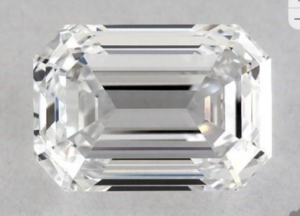
If you view one from the back, you’ll find it has tremendous depth and doesn’t come to the same sharp point as a round cut.
Emerald cuts are another alternative to a round engagement ring diamond that also has a lower price per carat.
Emerald cuts are often compared to baguette diamonds, and to the naked eye, they look similar.
Try spotting the difference between the two below.
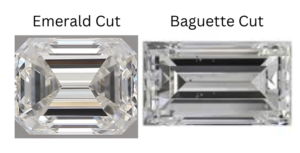
It’s the diagonal corners compared to the squared-off edges of a baguette cut.
What are the Differences Between Cushion and Emerald Cuts?
1. Cut
The difference between a cushion and emerald is the cut used to form the shape of the diamond and its facets.
A cushion cut is a type of brilliant cut. It’s designed to maximize brilliance and light return through the diamond’s table. The number and shape of the facets are cut in a way where light can enter and exit the diamond at the right angles.
If you zoom in on the image below, you can start to identify individual facets.
Although it’s difficult to determine where they start and end, it’s easy to tell the difference between those triangular- and kite-shaped facets and ones in an emerald cut.
Emeralds are a step-cut diamond. The facets are shaped like a set up stairs moving from the center of the diamond toward its edges.
The rectangular facets form a “hall of mirrors” effect, where facets appear to continue even as they reach the center.
Facets on step-cut diamonds are much larger than brilliant cuts. In a close-up photo, you can spot where one starts and ends and follow it along the table.
2. Shape
The naked eye often doesn’t notice how the individual facets are cut on a diamond.
Instead, what distinguishes one cut from the other is its overall shape. When comparing a cushion versus emerald cut, there’s no mistaking the two based on shape.
I’ve placed a cushion next to an emerald cut below.
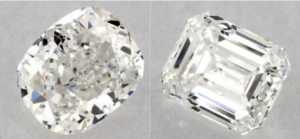
When placed side-by-side, the differences in their shape is apparent.
One pro of cushion cuts is they can be fashioned into multiple shapes, but the commonality between the variations is the rounded edges and squarish body. The most popular has a length 10-20 percent longer than the width, creating an obvious rectangular.
Emerald diamonds also have a rectangular shape, but their distinguishing characteristic is the cropped corners. They’re shaped in a way that creates eight sides but not the appearance of a traditional octagon, where all sides are equal.
As an example of the latter, here’s a comparison.
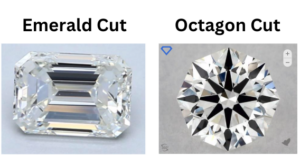
Instead, the four diagonal edges of an emerald cut are equal length, and then its four other sides have a matching side on the other end. This creates the elongated look.
A one carat emerald diamond is typically 7×5 millimeters. This ratio shifts as the diamond gets larger and smaller, so a small emerald might have a 1.5:1 ratio of length to width, while a large one could be 5:4.
Either way, most emerald cut diamonds aren’t a square shape.
3. Brilliance and Fire
Cushion cuts display more brilliance and fire than emerald cuts because they’re a brilliant cut. In fact, cushion cut diamonds are known for their intense fire compared to all other cuts except for round.
A diamond’s fire is produced when white light disperses into a rainbow of different colors. It’s a glimmer of colors radiating from the diamond in multiple directions.
In addition to a quality cut, a cushion cut diamond with excellent symmetry has more fire. The ideal arrangement of facets creates a better environment for refracting light.
And similar to its fire, you can expect strong brilliance from a cushion cut diamond because of its high number of facets formed at the right size and angle. It reflects both white and colored light.
The brilliance and fire of emerald cuts pale in comparison to cushion but are stronger than other cuts such as baguettes. The focus of a step-cut diamond isn’t on the best light performance because its facets aren’t triangular.
That doesn’t mean an emerald cut requires additional diamonds on the shank to achieve a sense of elegance. You can still place them in a solitaire setting, like the one below.
But many of its facets are rectangular, which don’t create the ideal angles for light to bounce in and off the diamond.
You can still find emerald cuts that don’t appear dull, but next to a cushion cut, the difference in brilliance and fire will be obvious.
4. Price
A pro of emerald and cushion cuts versus a round cut is a lower price per carat.
If a round diamond has all the same qualities as a cushion or emerald cut, the round cut would be the most expensive.
Between emerald and cushion cuts, there’s only a small price difference.
The reason they’re both more affordable than round brilliants is because most of the rough diamond is used in the final product. In other shapes, a larger percentage is discarded, so the price goes up.
To learn exact prices, I compared diamonds that have the same qualities, except one is cushion cut and the other is emerald. Their grades from the Gemological Institute of America are:
- Carat weight: 1.00
- Color: H
- Clarity: VS1
At James Allen, the average price for an emerald cut of that quality is $3,815. The average price for the cushion cut is $3,310.
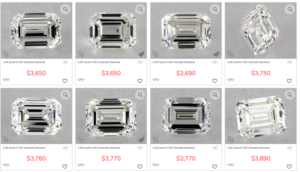
I did the same comparison with Blue Nile, another online jeweler.
The average price for the emerald cut is $4,477. For the cushion cut, it’s $4,135.
So you can expect to save from 7-15 percent by choosing a cushion cut over an emerald cut.
That’s enough savings to choose a higher carat weight or improved color or clarity grades.
5. Color
A diamond’s color is graded on a scale of D to Z, where D is colorless and Z indicates strong tints of yellow or brown.
Here’s a few grades across the scale to give you an idea of the difference in their visual appeal.
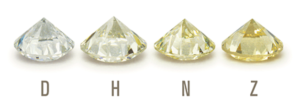
Cushion cuts hide color better than emerald cuts but rank lower on this ability compared to many others. Colorless diamonds are more valuable than ones that show tints of yellow or brown, so the more colorless it appears, the higher the price.
While a diamond graded a D on the GIA color scale is truly colorless, most buyers are concerned with how the diamond appears to the naked eye. The goal is to find a diamond that looks colorless but doesn’t command the premium price of a colorless grade.
To provide a clear example of the impact of low color grades, here’s an emerald cut with a K color grade.
The yellow is obvious with magnification, and it’d still be noticeable when viewed in a normal setting.
For cushion cuts, an I or H color grade generally hides the yellow tint. For emerald cuts, I recommend H or higher.
Start at those grades and work your way up the scale until you find one that appears colorless. You’ll likely spend 10 to 15 percent more with every step up.
The emerald’s step-cut produces less brilliance, so it doesn’t hide color as well as brilliant cuts.
This emerald cut earned a G color grade, which is the highest in the “near colorless” category of the color scale.
There’s no yellow with magnification, which means it would also appear colorless to the naked eye.
But don’t rely on the grading report to tell you whether the color is visible. View the diamond in person or through high-resolution images.
6. Clarity
A diamond’s clarity is graded on the presence and visibility of inclusions, or imperfections, in the diamond.
Cushion cuts hide inclusions more than emerald cuts, so you’ll have a stronger degree of clarity with a cushion cut.
This is because of it has a higher degree of brilliance. The white and colored light reflecting from the stone hides those dark blemishes.
Most diamonds buyers are concerned with finding an eye-clean diamond, which means the inclusions aren’t visible to the naked eye. A cushion cut with a clarity grade of SI1 or above is often eye-clean, but you should always view the diamond in person or in high-quality photos.
For example, this cushion cut earned an SI1 clarity grade.
Take the time to view it at multiple angles. Even though the GIA report identifies crystals and feathers, they likely aren’t visible without 10x magnification.
For an emerald cut, it might require VS2 if you want the same effect.
Similar to color, start at those grades and then work your way up, because you’ll pay a premium as you move toward flawless.
7. Popularity
Cushion cuts are more popular than emerald cuts, especially for engagement rings. They’re the third most popular choice behind round and princess.
The engagement ring below features a cushion cut surrounded by a halo.
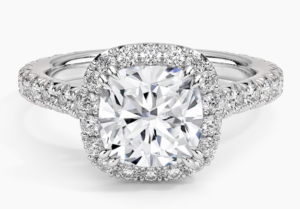
As you can see, it creates a stunning yet simple piece.
Even though about three percent of diamonds on the market are emerald cuts, they’re one of the most popular step-cuts, compared to others such as Carré and Asscher.
If you do find an emerald cut for an engagement ring diamond, it’s often paired with baguette cuts surrounding it on each side, like in this example.
The rectangular shape of the tapered baguettes complements the emerald cut in the middle.
But the numbers above are estimates for the general public. I evaluated 250 celebrity engagement rings to learn if they’re choices of cuts differed.
In my research, emerald cuts were the third most popular pick, representing 18 percent of celebrity engagement rings.
Cushion cuts landed in fourth, with 14 percent.
8. Durability
Two factors that influence durability are the type and size of inclusions and whether the diamond has sharp corners.
Emerald cuts are considered durable because the corners are cropped.
You don’t have to worry as much about a sharp corner chipping if it experiences impact.
The same idea is true of a cushion cut because of its rounded edges.
In regard to inclusions, its structure can be weakened whether it’s a cushion or emerald cut. Large inclusions such as feathers or cavities create weak points, so hard impact can cause it to chip.
If you choose a cushion or emerald cut with at least an SI1 clarity grade, you generally don’t need to worry about inclusions causing it to lack durability.
That being said, always protect your diamond with a quality setting and remove it during physical activity.
9. Varieties
There are more varieties of cuts within the cushion category compared to emerald cuts. These options include:
- Antique cushion cuts
- Modern
- Cushion brilliant
- Modified cushion
- Crushed ice
- Elongated
Each consists of the same traditional rounded edges and brilliant cut. The differences are in the way the individual facets are cut.
As an example, this cushion cut has facets that appear as crushed ice.
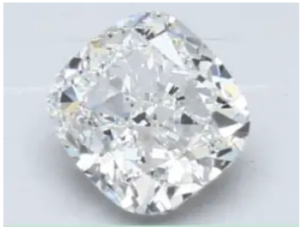
This trait is especially obvious in the middle.
It has an extra row of facets below the girdle to create this crushed ice aesthetic. The cutter saves more of the original rough diamond, so the price is lower.
With each variation of the cushion cut, you’ll find it has a unique appearance that comes with pros and cons.
The most significant variations for emerald cut diamonds are the length-to-width ratios. It can stretch from a rectangle down to a 1:1 ratio. With larger ratios, the diamond appears more slim.
Here’s an image of two emerald cuts with different ratios.

The one on the left clearly has longer lengths than widths, while the the one of the right is is closer to a square shape.
Are There Similarities?
I’ll highlight two similarities between cushion and emerald cuts.
First, they’re both part of the category of diamonds known as fancy shapes.
Fancy shapes are any shape other than a round diamond, which also includes marquise, Asscher, radiant, and oval. They’re all less expensive than a round cut and have unique shapes and ways they reflect light.
The second is both emerald and cushion cuts work in a variety of settings. Once you’ve chosen the perfect diamond, your next step is to find the setting.
Prongs are the most common, but they both work in bezel settings, which provide protection for the diamond all the way around.
You can enhance the sparkle of the piece by adding accents along the shank or choosing a channel setting.
Is a Cushion or Emerald Cut Right for You?
Choosing between a cushion and emerald cut diamond involves comparing their traits such as facets, shapes, price, and more.
Here are a few guidelines to help you decide.
Consider a cushion cut if:
- You’re interested in an alternative to round cuts that still have strong brilliance and fire
- You want a lower cost per carat
- One of its variations, such as an antique or crushed ice cushion, is appealing
An emerald cut might be right for you if:
- You don’t mind its lack of brilliance but instead prefer its soft glow
- You’re willing to choose a higher color and clarity grade so it still appears colorless and eye-clean
- Its elongated shape is more desirable
Compare several cushion and emerald cuts, including the variety of settings available for each.
By understanding the qualities that make them unique, you can select the diamond cut that’s right for you.

Jacob Clarke
Jacob Clarke is the founder of TeachJewelry.com.
He earned an Applied Jewelry Professional Diploma from the Gemological Institute of America (GIA) and now brings you essential information about diamonds, settings, and more.
Jacob has consulted with leading jewelry brands, and his work has been cited in Clean Origin, Diamond Nexus and industry publications.
He's also a member of the International Gem Society.
He enjoys discussing jewelry with readers, so contact him with any questions at jacob.clarke@teachjewelry.com.

